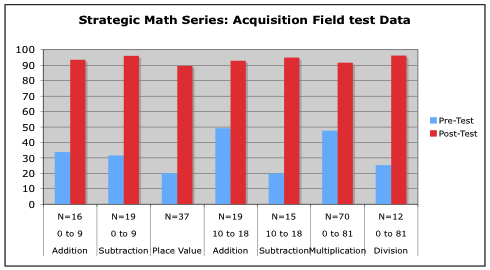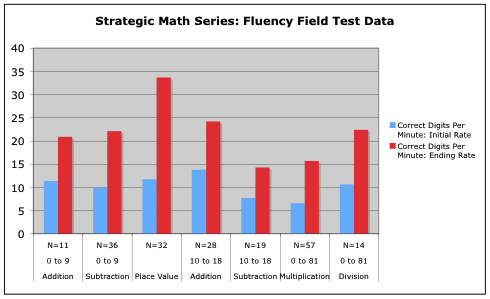Additional information
| Dimensions | 8.5 × 11 in |
|---|---|
| Cover | Paperback |
| Dimensions (W) | 8 1/2" |
| Dimensions (H) | 11" |
| Page Count | 148 |
| Publisher | CRL |
| Year Printed | 1994 |
| Dimensions | 8.5 × 11 in |
|---|---|
| Cover | Paperback |
| Dimensions (W) | 8 1/2" |
| Dimensions (H) | 11" |
| Page Count | 148 |
| Publisher | CRL |
| Year Printed | 1994 |
Overview
Multiple field tests were conducted that involved 56 teachers and 248 elementary students who were experiencing difficulties learning math. These field tests took place in seven school districts in self-contained, resource, and general education classes. The teachers were trained to use programs in the Math Strategies Series. Different groups of students were taught addition facts, subtraction facts, multiplication facts, division facts, and place-value concepts and skills, depending on their needs. The teachers followed the step-by-step instructions in the appropriate instructor’s manual, depending on the skills to be learned.
Results
Substantial gains were made by the students in all areas. See the figures below for the results in each math area. Figure 1 shows the results on untimed acquisition tests, and Figure 2 shows the results on timed proficiency tests (i.e., fluency tests). The number of students participating in each field test is shown beneath each pair of bars on the graph.
Figure 1: Percentage of answers correct on untimed acquisition tests

Figure 2: Number of digits correct per minute on fluency tests

The results for the Subtraction Facts 0 to 18 program are shown in the fifth pair of bar graphs in each figure. For the Subtraction Facts 10 to 18 program, students earned a mean score of 20% on the untimed acquisition pretest and a mean score of 95% on the posttest. They produced an average of 8 digits per minute in baseline and 14 digits per minute after instruction.
Conclusions
The programs in the Strategic Math Series produce significant gains in student performance on math acquisition and fluency tests across several areas of mathematics. In addition, these programs all produce socially significant final performances with students earning scores around or above the 90% level on acquisition tests in all areas.
Reference
Miller, S. P., & Mercer, C.D. (1998). Strategic Math Series professional developer’s guide. Lawrence, KS: Edge Enterprises.

Susan P. Miller, Ph.D.
Affliations
My Background and Interests
I am a Professor of Special Education at the University of Nevada Las Vegas (UNLV). In this role, I teach courses in learning strategies, instructional methodology, and leadership. My research interests focus on learning strategies and mathematics interventions. I’ve had the opportunity to share much of what I know as author of Validated Practices for Teaching Students with Diverse Needs and Abilities and as co-author of Designing and Implementing Mathematics Instruction for Students with Diverse Learning Needs, and the Strategic Math Series. Prior to joining the faculty at UNLV, I worked as Program Administrator for the Multidisciplinary Diagnostic and Training Program at the University of Florida. Additionally, I’ve taught students with and without disabilities at the elementary and secondary levels. As a high-school general education teacher, I taught social science courses and compensatory mathematics. As a junior-high general education teacher, I taught geography and American history. As a middle-school special education teacher, I taught reading, and as an elementary diagnostic classroom teacher, I taught math, reading, and language arts to students with medical, learning, and behavioral challenges.
The Story Behind the Strategic Math Series
Arithmetic and mathematics were my least preferred subjects in the school curricula as a child and teenager. I spent a good bit of time memorizing procedures to get correct answers without truly understanding the meaning behind those procedures. From an early age, becoming a teacher was high on my list of goals, but I never imagined that mathematics would be the subject I’d teach. As fate would have it, my teaching assignments at both the elementary and high school levels included mathematics. It wasn’t until I began teaching math that I realized it was not math that I had disliked all those years, but it was the way I had been taught math. That realization launched my dedication to finding better ways to teach this complex area of the curriculum. Cecil Mercer, my doctoral mentor at the University of Florida (Go Gators!), also was interested in determining effective ways to teach mathematics. Thus, when dissertation time arrived, we designed a study that involved the use of the Concrete-Representational-Abstract (CRA) teaching sequence to help students acquire an understanding of place value. The positive results obtained in this dissertation study caused us to launch a series of studies and field tests related to teaching basic math facts using the CRA sequence with integrated strategy instruction, a graduated word problem sequence, math timings, and numerous PIG dice games to make math practice fun. The positive outcomes for students and positive feedback from their teachers motivated us to share our results with Jean Schumaker and Don Deshler, and shortly thereafter the Strategic Math Series was born!
My Thoughts about the Strategic Math Series
I have enjoyed witnessing the positive effects of Strategic Math Series instruction on students who struggle with their basic math facts and place-value skills. Students who receive this instruction develop conceptual understanding, learn to use procedural strategies, and develop fluency related to the basic math facts. Students also learn to attack word problems without fear, and they absolutely love the Pig Games! Engagement in these games provides the extensive practice needed for skill mastery and keeps student motivation high. Mathematics is hierarchical with one skill building on the next. Mastery of basic math facts and place value understanding is needed for students to progress through the mathematics curriculum. Without this understanding, higher level mathematics skills are a tremendous challenge for teachers to teach and students to learn. Fortunately, this program sets students up for future success in their mathematics endeavors.
Teacher and Student Feedback on the Strategic Math Series
Teachers routinely tell me that the math strategies instruction is easy to implement and that their students love it. They report that the students really understand addition, subtraction, place value, multiplication, and division when they finish the instructional lessons. Teachers who use a variety of comprehensive mathematics programs say that the Strategic Math Series is a wonderful supplement to these programs. They note that students need this supplemental instruction and practice to be successful in math. When Cecil Mercer and I conducted the field tests for the series, we had opportunities to talk with many teachers and to read their written feedback about the lessons. The 56 teachers involved in these field tests were overwhelmingly positive and indicated they would continue to use the program even though the field tests were complete. Written feedback from the students was very positive as well. I recently received a letter from a parent-volunteer who was using the program with her son and another child in an elementary resource room setting. She noted that the students were engaged and enthusiastic and wrote, “I’m so excited about how rapidly both children are progressing and what good feelings the children are experiencing due to their success.”
My Contact Information
Susan P. Miller, Ph.D.
Professor
Department of Special Education-Box 453014
University of Nevada Las Vegas
Las Vegas, NV 89154
Email: millersp@unlv.nevada.edu
Work Phone: 702 895-1108

 Subtraction With Regrouping
Subtraction With Regrouping